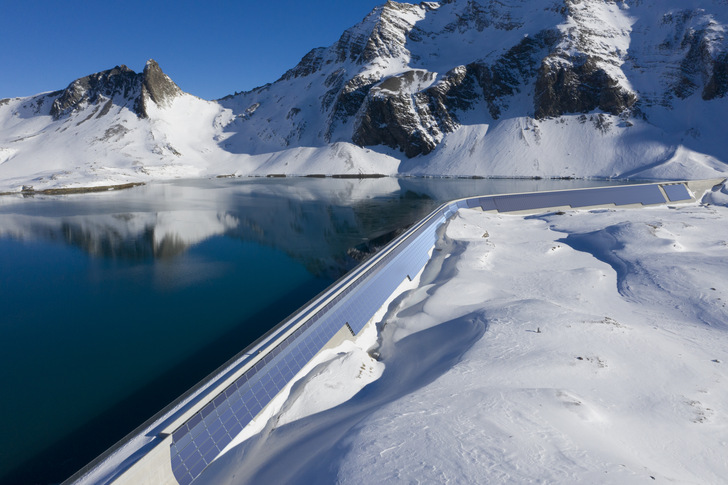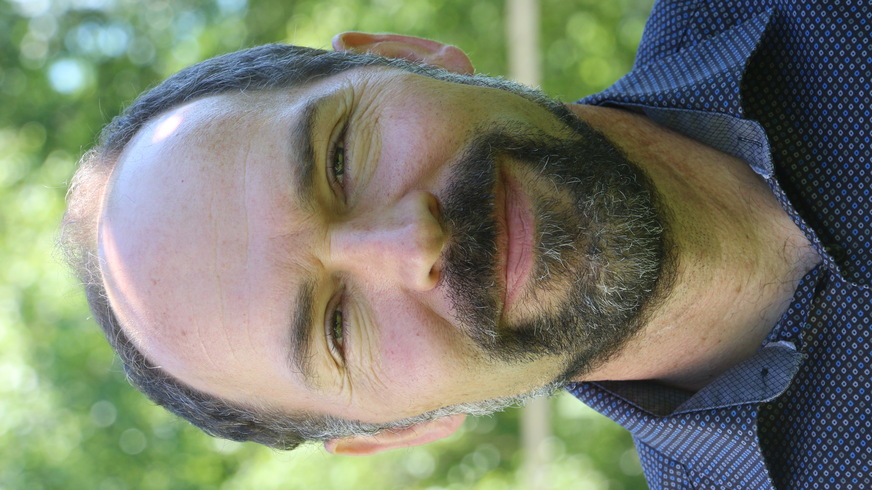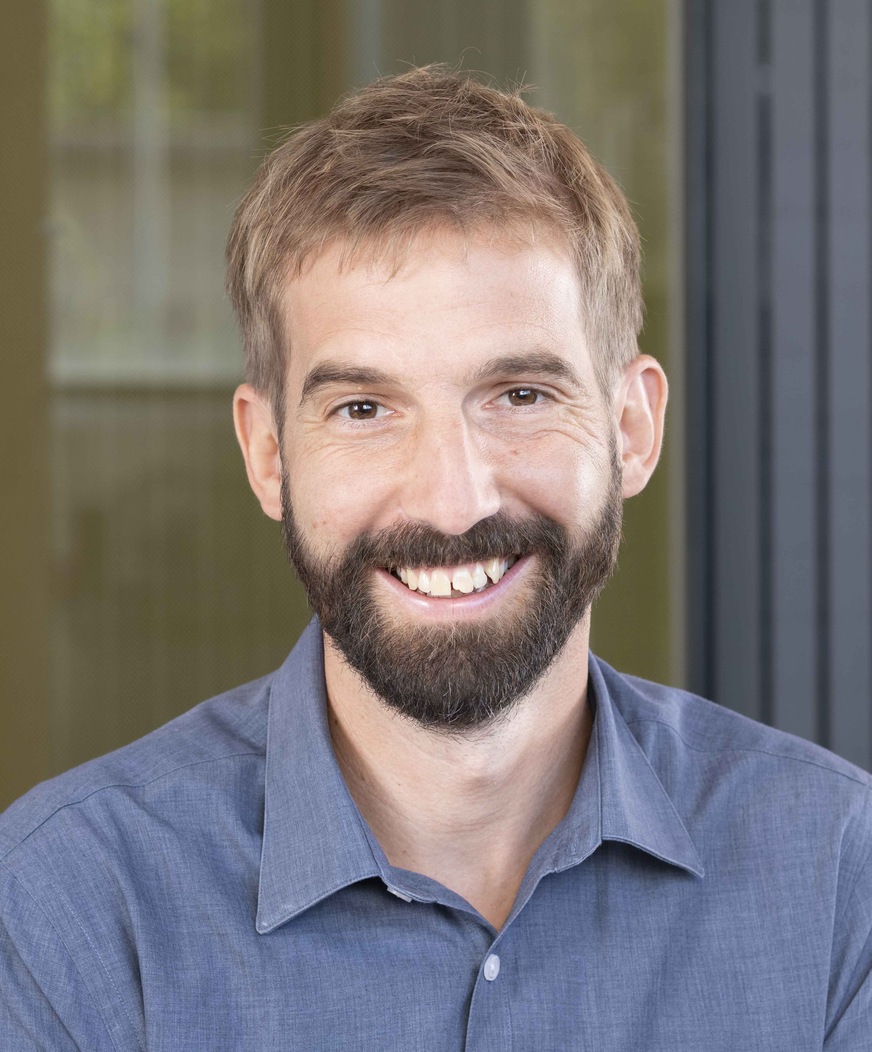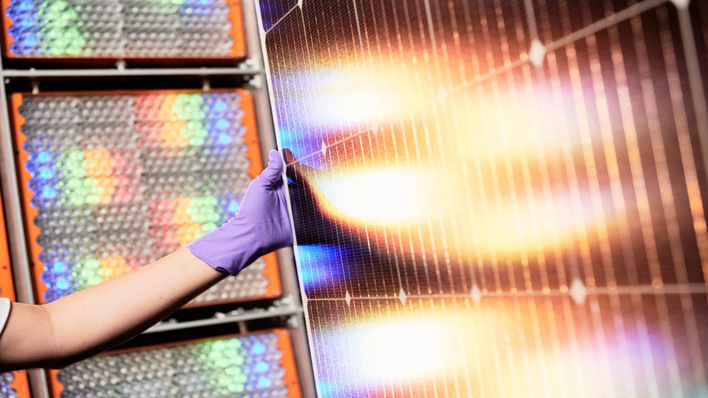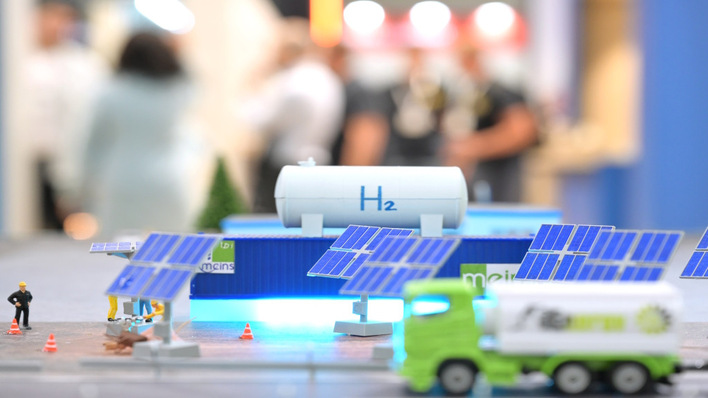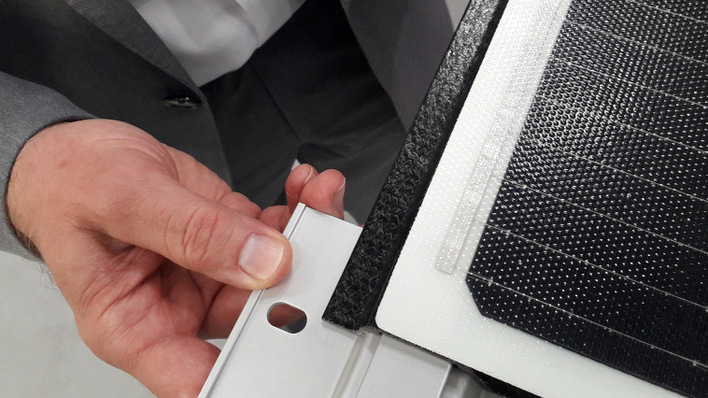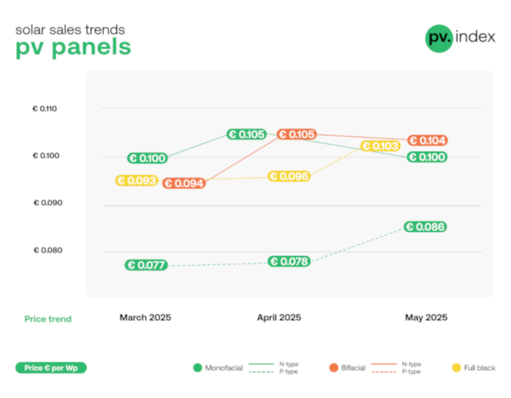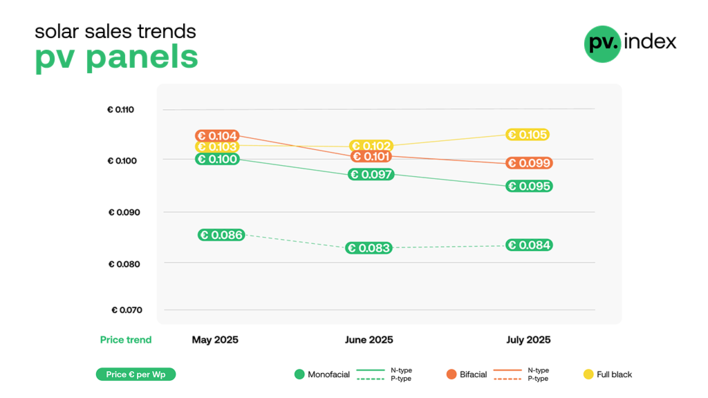Since its opening in 2016, the Muttsee dam of the Swiss pumped storage plant in Limmern in the Glarus Alps has been the highest in Europe. In 2021, another record will be set right up there: 2,500 metres above sea level, an almost one-kilometre-wide solar power plant with an output of 2.2 megawatts is to be built on the hydroelectric power plant's dam wall from mid-June 2021. The targeted solar yields are expected to out-perform the average for the Swiss midlands by 50 per cent. The entire plant is expected to deliver 3.3 gigawatt hours of electricity annually, which would correspond to 1,500 kilowatt hours per kilowatt of installed output.
In a study conducted in March 2019 by Swissolar and Meteotest on behalf of the Swiss Federal Office of Energy (SFOE), the authors determined a solar potential of 16.4 terawatt hours for Switzerland's alpine open spaces. Of this, 3.3 terawatt hours could already be used in the short to medium term, and around 1.6 terawatt hours could be produced just in the winter half of the year. By comparison, electricity consumption in Switzerland was around 57 terawatt hours in 2019.
Highest yields in February and March
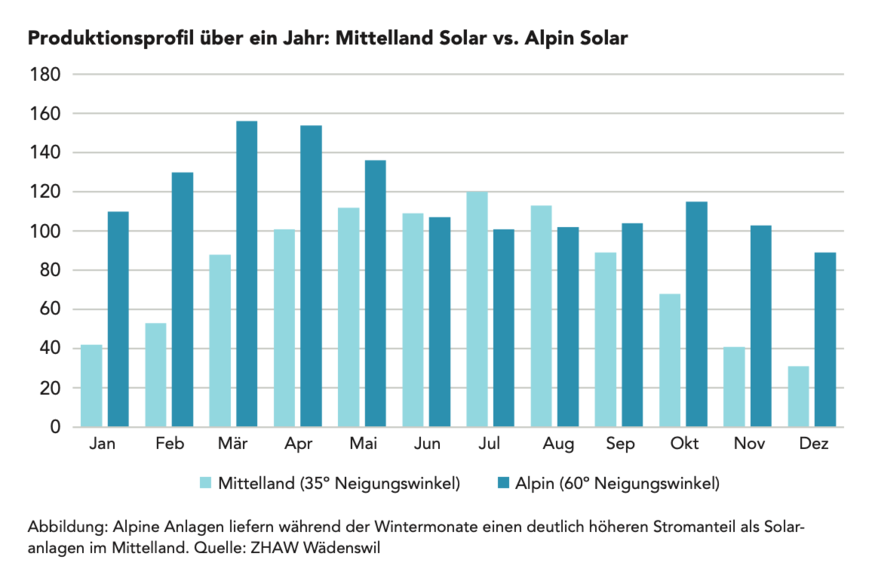
ZHAW Wädenswil
Photovoltaics as a supplier of winter electricity - that not only sounds charming, it also brings tangible advantages: The high location in the Alps ensures significantly more direct sunlight because layers of fog or clouds rarely obstruct the sun. The albedo effect, i.e. the reflection of light back from the ground, increases the electricity yield even more. The steeper inclination of the modules favours a more effective angle of incidence. In addition, the dam wall is already conveniently oriented to the south-southeast and south-southwest. The natural cooling and rear ventilation, further increases the efficiency of the solar modules.
See also: New transport corridor from the Rhine to the Alps
The highest yields from the system are expected in February and March, but overall the output will be relatively balanced over the entire year - quite unlike conventional roof systems in the Swiss midlands.
Reservoir wall under observation
The potential for solar power generation was already recognised when the upper reservoir of the Limmern pumped storage plant was completed. In the first five years, however, the dam wall had to be intensively monitored, and only then could the plans for a solar power plant be accelerated.
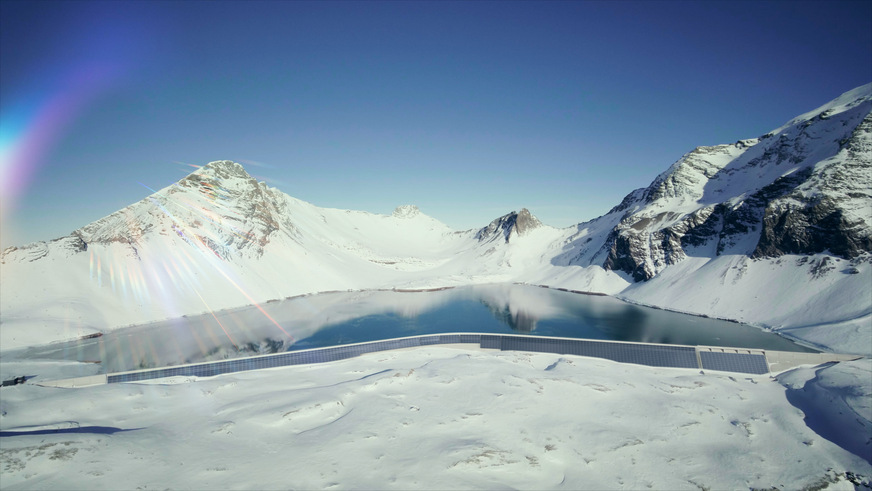
Axpo
Approval for the project went through a three-stage process from the municipality to the canton to the federal level of the Swiss authorities and in January 2021 the energy provider Axpo was finally able to officially announce its intention to implement the pioneering Alpinsolar project. In the meantime, the Basel municipal utility IWB is also contributing 49 per cent of the costs. In addition, the EPFL University of Applied Sciences in Lausanne and the Institute for Snow and Avalanche Research (SLF) in Davos will accompany the project scientifically in order to determine radiation and yield measurements from the mountains in even greater detail.
Alpine weather as a risk factor
After several years of planning, construction will finally begin this coming summer, and on an extremely tight schedule: The plant is to be installed between mid-June and mid-September 2021. Under optimal conditions, the solar power plant could be up and running within 35 to 40 working days. However, the weather in the Alps is difficult to predict; there will be days when construction cannot proceed. A sufficient buffer must be factored in for such cases.
The climate at 2,500 metres is harsh and changeable. Above all, snow loads must be taken into account, even in the summer months. However, the project planners do not have to collect complex wind measurements on their own, as there are two active weather stations near the dam, one of which is only two kilometres away. The weather data gathered by these, together with precipitation forecasts, could already be used to simulate the installation in a model and to plan for an important challenge from the outset: The lower five metres of the wall must remain free for potential snow deposits.
Bifacial glass-glass modules from Megasol
Of course, the solar modules used also have be able to withstand the snow. That is why 4,872 bifacial glass-glass modules from the Swiss manufacturer Megasol are being installed. Their wide 40-millimetre frame meets the requirements for the expected snow loads. In those areas of the module where the highest load is expected, additional support must therefore be provided centrally from behind at one point. This is the only way to ensure that the glass will hold up and not bend too much.
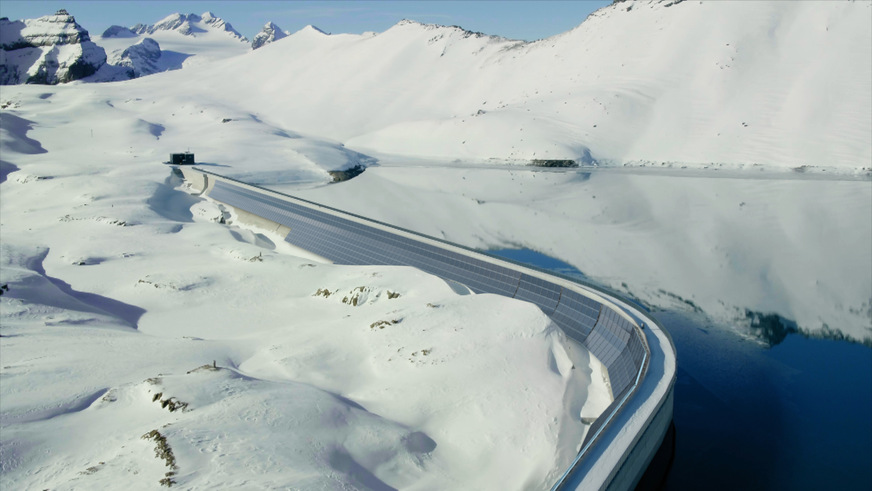
Axpo
In order to make the best possible use of the available space, Megasol uses two different module types with outputs of 460 watts and 385 watts respectively. Installers pre-install them on 14.5-metre-wide module tables for final placement on the dam wall. Over the course of six months, the mounting system itself was completely redesigned by the general contractor Plan-eco and its project partners Megasol and Crestageo. Put simply, it is a commercially available insertion system for modules that has never been built before on this scale. The vertical primary substructure consists of steel trusses, but the tools for the aluminium profiles had to be specially made for Alpinsolar.
String inverters from Kaco
The modules feed into a total of 23 Kaco Blueplanet string inverters, each with 105 kilowatts of DC output. With their outputs greater than the AC output by a factor of 1.1, these are deliberately over-dimensioned because the operators expect higher winter yields due to the albedo effect and power gains from the bifacial modules. The output voltage of 400 volts makes it possible to connect the inverters directly to the transformer without additional costs. The silicon carbide circuit breakers of the string inverters are characterised by their high thermal load capacity and actually allow for overloading by 1.5 times the AC output.
Even if the modules are not shaded by trees or buildings, snow remains a dominant issue even when planning the strings. Modules where snow accumulation is likely were connected together. Heavy snowfall would thus only affect three inverters would, to the effect that they might not deliver any yields. On the other modules strings, the snow can slide off relatively quickly, as they will be inclined at a steep angle of 51 or as much as 60 degrees. At the expected quantities, the snow cannot and must not be removed manually. On the other hand, automated solutions will not be available, if only for reasons of cost. However, for snow to accumulate on the ground higher than the five metres already taken into account in the simulation is quite unlikely.
Work only possible in flying weather
Logistically, the construction is a daring undertaking: Although the caretaker's house at the Limmern hydroelectric plant is accessible all year round, there is no road that could be used to transport materials and personnel to and from the site. The entire construction site has to be supplied by transport helicopter. On the one hand, this is demanding, but above all it is expensive. The construction has to be completed within three months in summer.
A required lifting crane, for example, is first dismantled down in the valley, then flown up in individual parts and reassembled at the top of the wall. The prefabricated and already wired-up module tables are lifted into the wall by the crane and only fixed in place. Active construction is only allowed to take place in flying weather, not only to safely transport all the materials, but also to be able to fly out any injured personnel without risk. When all is said and done, the inevitably larger CO2 footprint resulting from the use of helicopters will be offset within three months of plant operation.
Ensuring maintenance work on the wall
Even following a successful commissioning, Alpinsolar will be a project with special challenges: Although the Muttsee dam allows the solar plant to be erected on stable ground, dam safety will still require continuous visual safety monitoring. A registry of cracks must be drawn up at least every five years and the wall must be easily accessible for technicians, especially in emergencies such as earthquakes. For this reason, the solar modules are built at a distance of 1.5 metres from the wall.
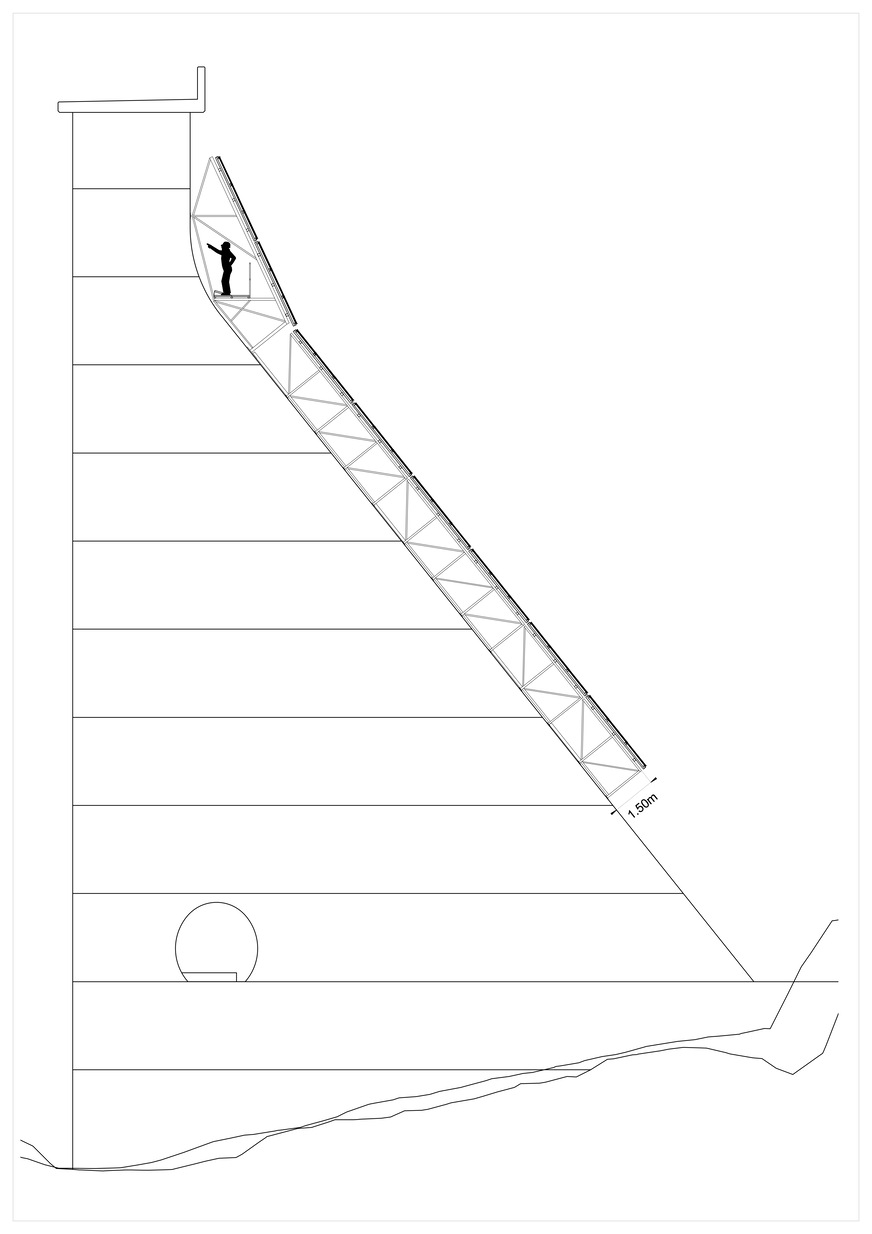
Axpo
In order to keep the solar plant accessible for maintenance work, a maintenance corridor with railings is being built in the upper area between the modules and the dam wall. Cables with a cross-section of 240 square millimetres run from the 23 junction boxes to the technical building. The already connected hydroelectric power plant feeds into a 16-kilovolt grid for the power plant's own supply. The newly installed solar power plant is connected to the technical centre in a power plant tunnel 900 metres away.
Support through a one-off payment
So far, Swiss regulations only allow green power plants to be built on top of existing infrastructure, such as the hydroelectric power plant at Lake Muttsee. This severely limits the solar potential that Swissolar and Meteotest determined in their study. A supplementary tendering programme could multiply solar expansion in Switzerland, but there is currently no political support for this. Larger rooftop systems are therefore usually only profitable in combination with guaranteed one-off payments and correspondingly high self-consumption by large electricity consumers.
See also: Switzerland: Massive expansion of renewables is needed
This is another reason why an innovative project like Alpinsolar is not yet economically viable under the current framework conditions. Large ground-mounted systems that do not directly serve self-consumption simply fall through the cracks under the current Swiss subsidy regime. The current one-off subsidy of 300 Swiss francs per kilowatt of output has been promised to the Muttsee plant, which corresponds to about 600,000 Swiss francs. However, this by no means covers the additional costs for the complex installation and safety of the Alpinsolar project.
Switzerland's first PPA
For this reason, Alpinsolar is not only technically a pioneering achievement, but also a financial breakthrough. In the run-up to the project, a long-term power purchase agreement (PPA) was signed with Denner, Switzerland's largest discount supermarket chain, for a period of 20 years and at a rate above the current market price. This is the first ever PPA for a large solar plant in Switzerland. The Denner company thus implements its own sustainability strategy.
Since all nuclear power plants in Switzerland will gradually be taken offline over the next few decades, CO2-neutral electricity generation via tenders for ground-mounted PV plants will have to be pushed in the future. In 2019, the share of solar power nationwide was as little as 3.8 per cent, but this could be greatly increased in the future. If Swiss policymakers take their own climate targets seriously and make an effort to achieve them, they will have to make swift adjustments in this regard. (mfo)
See here an update for the start of construction of the Alpinsolar project.


